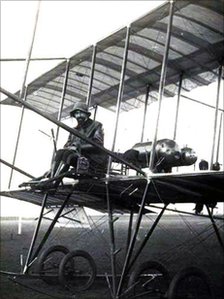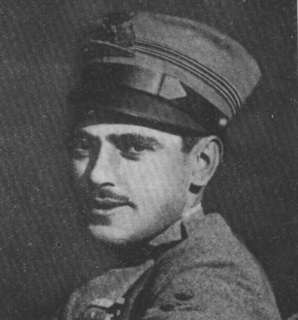 W
WLieutenant Giovanni 'Giannino' Ancillotto was an Italian World War I flying ace credited with 11 confirmed aerial victories. Rather unusually, he served solely with aviation while he was in the military, beginning in the lowest rank. Among his aerial victories as a fighter pilot were three over enemy observation balloons right after the Battle of Caporetto. As an example of the hazards of balloon busting, on 5 December 1917 Ancillotto returned to base with singed swatches of the third balloon's fabric adhering to his damaged fighter plane.
 W
WCount Francesco Baracca was Italy's top fighter ace of World War I. He was credited with 34 aerial victories. The emblem he wore side by side on his plane of a black horse prancing on its two rear hooves inspired Enzo Ferrari to use it on his racing car and later in his automotive company.
 W
WLuigi Broglio, was an Italian aerospace engineer, airforce lieutenant colonel and dean of the school of aeronautical engineering at the University of Rome La Sapienza. Known as "the Italian von Braun", he is best known as the architect of the San Marco programme which led Italy to be the third country in the world to build and operate its own satellite.
 W
WMaurizio Cocciolone is an Italian Air Force officer, who served with UN Coalition forces and was a prisoner of war during the Gulf War.
 W
WCaptain Samantha Cristoforetti is an Italian European Space Agency astronaut, former Italian Air Force pilot and engineer. She holds the record for the longest uninterrupted spaceflight by a European astronaut, and until June 2017 held the record for the longest single space flight by a woman until this was broken by Peggy Whitson and later by Christina Koch. She is also the first Italian woman in space.
 W
WGiulio Gavotti was an Italian lieutenant and pilot, who fought in the Italo-Turkish War. He set two firsts in the history of aerial warfare of heavier-than-air flyers: He was the first man to make an aerial bombardment, as well as the first to perform a night mission.
 W
WGuido Keller was an Italian aviator and political activist who was closely associated with Gabriele D’Annunzio and played an important role in the seizure of Fiume in 1919.
 W
WThe Kindu massacre, or Kindu atrocity, took place on 11 or 12 November 1961 in Kindu Port-Émpain, in the Congo-Léopoldville, where thirteen Italian airmen, members of the United Nations Operation in the Congo (ONUC), sent to pacify the country ravaged by civil war, were murdered. The Italian aviators manned two C-119s, twin-engined transport aircraft known as Flying Boxcars, of the 46ª Aerobrigata based at Pisa Airfield.
 W
WTenente colonnello Alvaro Leonardi was a World War I Sottotenente from Italy and a flying ace credited with eight aerial victories.
 W
WAntonio Lippi (1900–1957) was an Italian aviator. He participated to the Transatlantic flight organized by Italo Balbo and awarded with the Gold Medal of Aeronautic Valor to aeronautic valor of Regia Aeronautica.
 W
WAdriano Mantelli was an Italian aircraft designer who designed the Alaparma Baldo.
 W
WTito Minniti was an Italian pilot who was killed after he was captured by Ethiopians during the Second Italo-Abyssinian War in 1935 near Degehabur. His death and alleged torture became an atrocity story proffered by the Italian government to justify their use of mustard gas against Ethiopian civilians. Minniti was posthumously decorated with the Italian Gold Medal of Valor.
 W
WEttore Muti was an Italian aviator and Fascist politician. He was Party Secretary of the National Fascist Party from October 1939 until shortly after the entry of Italy into World War II on 10 June 1940.
 W
WColonel Luca Parmitano is an Italian astronaut in the European Astronaut Corps for the European Space Agency (ESA). He was selected as an ESA astronaut in May 2009. Parmitano is also a Colonel and test pilot for the Italian Air Force. Parmitano is the youngest non-Russian astronaut to undertake a long-duration mission, at 36 years and eight months old on the launch day of his mission.
 W
WTenente Silvio Scaroni was an Italian World War I fighter pilot credited with 26 victories. He was the second ranking Italian ace of the war.
 W
WMajor Adriano Visconti di Lampugnano was one of Italy's top flying aces of the Second World War, shooting down between 10 and 26 enemy aircraft. He was awarded with four Medaglia d'argento al Valor Militare and two Medaglia di Bronzo al Valor Militare "in action".